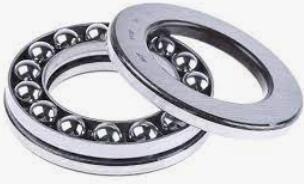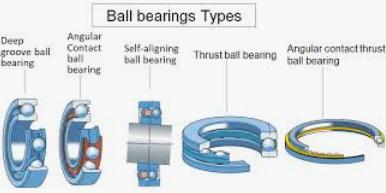Thrust Ball Bearings: Types, Advantages, Applications, and Maintenance
Thrust Ball Bearings: Learn about types, advantages, applications and maintenance.
Keep your machinery running smoothly with our comprehensive guide.
Thrust ball bearings are an essential component in many different types of machinery and equipment.
Did you know that thrust ball bearings are designed to handle axial loads and are commonly used in steering systems, gearboxes, and machine tools?
In this article, we will explore the types, advantages, applications, and maintenance of thrust ball bearings.
|
Types of thrust ball bearings |
Characteristics and advantages of thrust ball bearings |
Applications of thrust ball bearings
|
Maintenance of Thrust ball bearings |
|
Single-direction thrust ball bearings |
High load capacity and stiffness |
Automotive industry |
Keep the bearing clean |
|
Double-direction thrust ball bearings |
Low friction and noise |
Aerospace industry
|
Lubricate the bearing |
|
|
Easy to install and maintain |
Machine tools and equipment |
Check for wear, and Proper installation |
If you're looking for reliable bearings that can handle high axial loads, thrust ball bearings may be the perfect choice.
These bearings are known for their unique features. So, read on to learn more!
What is thrust ball bearing?

Thrust ball bearings are a type of rolling element bearing that is designed to handle axial loads.
Axial loads are forces that act parallel to the axis of rotation, as opposed to radial loads which act perpendicular to the axis of rotation.
Thrust ball bearings are specifically designed to handle high axial loads and can be found in a wide range of applications including automotive, aerospace, and industrial machinery.
The basic construction of a thrust ball bearing consists of a series of ball bearings held in place by a cage.
The balls are typically made of steel or ceramic and are designed to roll between two raceways, which are usually mounted on separate shafts.
One raceway is usually stationary, while the other rotates with the shaft.
The ball bearings in a thrust ball bearing are designed to handle axial loads by rolling between the raceways.
As the rotating shaft applies an axial load to the bearing, the balls roll along the raceways, reducing friction and allowing the shaft to rotate smoothly.
Thrust ball bearings are available in a range of sizes and load capacities, making them suitable for a variety of applications.
They are typically used in applications where the axial load is high, and the radial load is low.
Examples include steering systems in cars, industrial machinery, and aerospace applications.
Types of thrust ball bearings

Single direction thrust ball bearings:
As the name suggests, single-direction thrust ball bearings are designed to handle axial loads in one direction only.
They consist of two raceways and a series of ball bearings held in a cage.
The raceways are mounted on separate shafts, with one raceway being stationary and the other being able to rotate with the shaft.
Single direction thrust ball bearings are commonly used in applications where the axial load is unidirectional, such as in machine tool spindles and certain types of pumps.
They can handle relatively high axial loads and are relatively compact in size, making them a popular choice in many industries.
Double-direction thrust ball bearings:
Unlike single-direction thrust ball bearings, double-direction thrust ball bearings can handle axial loads in both directions.
They consist of two sets of raceways and ball bearings, each set mounted on a separate shaft.
The two sets of raceways are separated by a spacer, and the ball bearings are held in place by a cage.
Double-direction thrust ball bearings are typically used in applications where the axial load is bidirectional, such as in certain types of gearboxes and in the steering systems of some cars.
They can handle relatively high axial loads in both directions, making them suitable for a wider range of applications than single-direction thrust ball bearings.
Characteristics and advantages of thrust ball bearings
1.High load capacity and stiffness: Thrust ball bearings are designed to handle axial loads, which means they are able to support high loads in the direction of the axis of rotation.
They also have a high stiffness, which means they resist deformation when subjected to loads.
These characteristics make them ideal for use in applications where high loads and stiffness are required, such as in machine tool spindles and gearboxes.
2.Low friction and noise: Thrust ball bearings are designed to roll between two raceways, which reduces friction and wear.
This design also reduces noise, making thrust ball bearings suitable for applications where quiet operation is important, such as in the automotive industry.
3.Easy to install and maintain: Thrust ball bearings are relatively easy to install and maintain.
They are typically mounted using a press fit or set screws, and can be easily replaced when worn out.
This makes them a popular choice for applications where maintenance is required, such as in industrial machinery.
4.Compact size: Thrust ball bearings are relatively compact in size, which makes them suitable for use in applications where space is limited.
Their small size also makes them easy to integrate into existing designs, which can help reduce manufacturing costs.
5.Versatility: Thrust ball bearings are available in a wide range of sizes and load capacities, making them suitable for a variety of applications.
They can be used in both single-direction and double-direction configurations, and are commonly used in automotive, aerospace, and industrial machinery applications.
Applications of thrust ball bearings

1.Automotive industry: Thrust ball bearings are commonly used in automotive applications such as steering systems, wheel hubs, and transmissions.
In steering systems, thrust ball bearings are used to support the axial load generated by the steering mechanism.
In wheel hubs, they are used to support the axial load generated by the weight of the vehicle and the forces generated during cornering.
In transmissions, they are used to support the axial load generated by the gears.
2.Aerospace industry: Thrust ball bearings are used in various aerospace applications such as landing gear, thrust reversers, and engine mounts.
In landing gear, thrust ball bearings are used to support the axial load generated by the weight of the aircraft during landing and takeoff.
In thrust reversers, they are used to support the axial load generated by the reverse thrust.
In engine mounts, they are used to support the axial load generated by the weight of the engine.
3.Machine tools and equipment: Thrust ball bearings are commonly used in machine tools and equipment such as milling machines, lathes, and grinders.
In milling machines, thrust ball bearings are used to support the axial load generated by the cutting tool.
In lathes, they are used to support the axial load generated by the workpiece. In grinders, they are used to support the axial load generated by the grinding wheel.
Differences between thrust ball bearings and other types of bearings
Radial bearings vs. thrust bearings:
Radial bearings are designed to handle radial loads, which are forces that act perpendicular to the axis of rotation.
They are used in applications where the load is primarily radial, such as in electric motors and pumps.
Thrust bearings, on the other hand, are designed to handle axial loads and are used in applications where the load is primarily axial, such as in automotive steering systems and gearboxes.
Thrust ball bearings vs. thrust roller bearings:
Thrust ball bearings use balls to handle axial loads, while thrust roller bearings use rollers.
Thrust ball bearings are typically used in applications where the load is relatively light and the bearing size is limited, such as in certain types of pumps and gearboxes.
Thrust roller bearings are used in applications where the load is heavier and the bearing size can be larger, such as in certain types of heavy machinery.
Maintenance and troubleshooting tips for thrust ball bearings
Maintenance Tips:
1.Keep the bearing clean: Dirt and debris can cause premature wear and failure of the bearing. Clean the bearing regularly using a soft cloth or brush and a mild solvent.
2.Lubricate the bearing: Proper lubrication can reduce friction and wear, and extend the life of the bearing.
Follow the manufacturer's recommended lubrication schedule and use the recommended type and amount of lubricant.
3.Check for wear: Regularly inspect the bearing for signs of wear, such as discoloration, pitting, or cracks. Replace the bearing if any signs of wear are detected.
4.Proper installation: Ensure that the bearing is properly installed, with the correct fit and clearance, and that the shaft and housing are aligned properly.
Troubleshooting Tips:
1.Abnormal noise: If the bearing is making an abnormal noise, such as a clicking or grinding sound, it may be a sign of damage or wear.
Inspect the bearing and replace if necessary.
2.Overheating: If the bearing is overheating, it may be a sign of improper lubrication or misalignment.
Check the lubrication and alignment and make any necessary adjustments.
3.Vibration: If the bearing is vibrating excessively, it may be a sign of misalignment or bearing damage.
Check the alignment and inspect the bearing for signs of wear.
4.Seizure: If the bearing is seizing, it may be a sign of inadequate lubrication or excessive load.
Check the lubrication and load and make any necessary adjustments.
Conclusion
In conclusion, thrust ball bearings are a versatile and important component in many industries, including automotive, aerospace, and machine tools.
They offer advantages such as high load capacity and stiffness, low friction and noise, and ease of installation and maintenance.
Proper maintenance and troubleshooting are essential for optimal performance and longevity.





